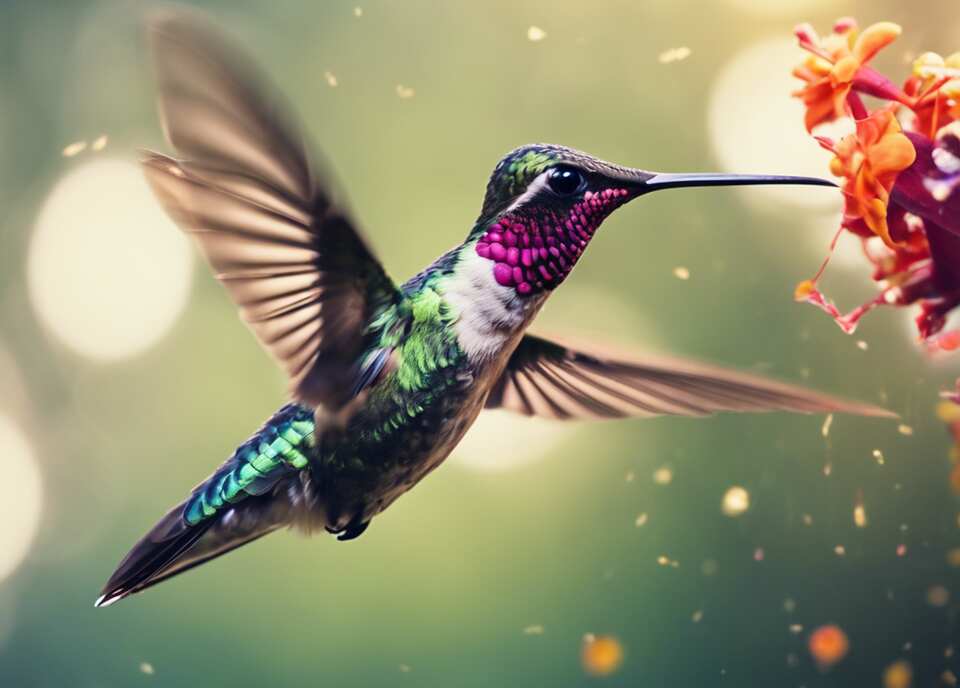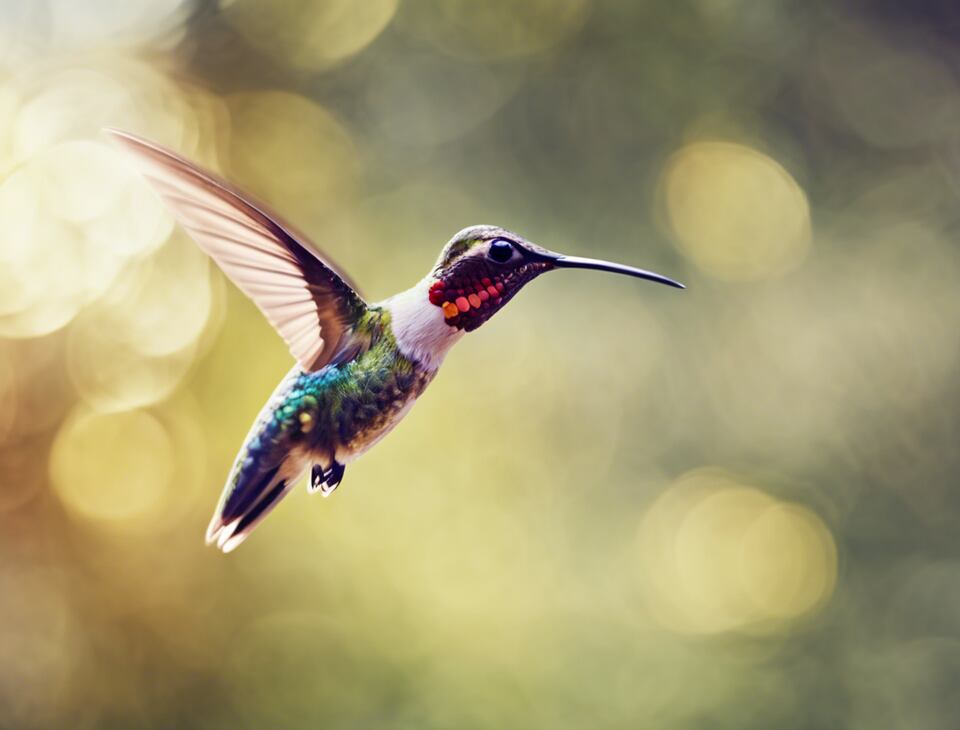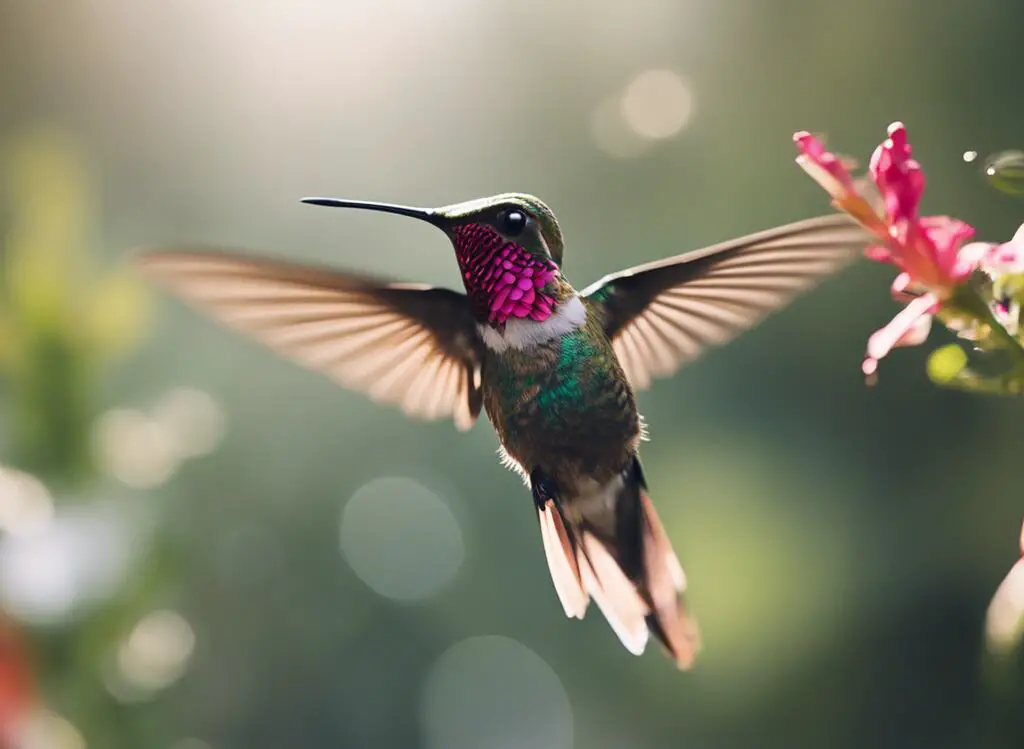Hummingbirds are fascinating creatures known for their unique characteristics, one of which includes their rapid wing movements. Have you ever wondered just how fast these tiny birds flap their wings to remain suspended in the air?
Table of Contents [show]
How Fast Do Hummingbirds Flap Their Wings?
Hummingbird Wing Speed
Hummingbird wings can flap at an astonishing speed, varying among the different species. On average, these birds flap their wings around 50 to 80 times per second during normal flight. This incredible speed allows them to hover in mid-air, fly backward, and perform agile aerial maneuvers with precision.
Common Hummingbirds and Wing Speeds
| Hummingbird Species | Wing Speed (beats per second) |
|---|---|
| Ruby-throated Hummingbird | 53 |
| Rufous Hummingbird | 62 |
| Anna’s Hummingbird | 50 |
| Broad-tailed Hummingbird | 49 |
| Black-chinned Hummingbird | 55 |
| Calliope Hummingbird | 62 |
| Costa’s Hummingbird | 48 |
| Allen’s Hummingbird | 55 |
Hummingbirds are known for their incredibly fast wing beats, which allow them to hover in place and perform remarkable aerial maneuvers. The wing speeds listed here are approximate averages, as individual birds can vary slightly. The Rufous and Calliope hummingbirds have some of the fastest wing beats among this group, reaching over 60 beats per second.
Factors Influencing Wing Speed
Several factors influence the speed at which hummingbirds flap their wings. One critical factor is the size of the bird. Smaller hummingbird species tend to have faster wingbeats compared to larger ones. Additionally, the purpose of the wing movement also plays a role. During normal flight, the wing speed is steady, but it increases significantly during moments of aggression or courtship displays.
Impact of Wing Speed on Flight
The high wing speed of hummingbirds is directly related to their ability to hover in the air. This unique flying technique sets them apart from other bird species. By rapidly flapping their wings, hummingbirds create enough lift to counteract gravity, allowing them to remain stationary in the air while feeding on nectar from flowers.
Comparison to Other Birds
In comparison to other bird species, hummingbirds have the fastest wingbeats. While most birds flap their wings at a rate of 5 to 10 times per second, hummingbirds far exceed this speed. This remarkable adaptation enables them to access food sources that other birds cannot reach, giving them a competitive advantage in the wild.
Evolutionary Adaptations
The rapid wing speed of hummingbirds is a result of evolutionary adaptations that have occurred over millions of years. Their unique flying capabilities have evolved to suit their specialized dietary needs and habitats. By developing such rapid wingbeats, hummingbirds have become expert foragers and are well-equipped to thrive in diverse environments.
Conservation Considerations
Understanding the intricate details of how fast hummingbirds flap their wings is not only fascinating from a scientific standpoint but also crucial for their conservation. As these birds face various threats in the wild, such as habitat loss and climate change, studying their unique characteristics can aid conservation efforts to protect these mesmerizing creatures for future generations to enjoy.
The speed at which hummingbirds flap their wings is truly impressive, showcasing the remarkable capabilities of these tiny avian marvels. By delving deeper into the factors influencing their wing speed and flight patterns, we can gain a greater appreciation for the complexity of nature’s creations.

The Impact of Wing Speed on Hummingbird Behavior
Hummingbirds are fascinating creatures known for their agility, vibrant colors, and unique flying abilities. One of the most intriguing aspects of hummingbirds is their wing speed, which plays a crucial role in their behavior and survival. In this article, we will explore the impact of wing speed on hummingbird behavior and shed light on the incredible capabilities of these tiny yet mighty birds.
Understanding Hummingbird Wing Speed
Hummingbirds are famous for their rapid wingbeats, which enable them to hover in place, fly backward, and move with precision and speed. On average, hummingbirds flap their wings between 50 to 80 times per second during normal flight. However, this number can increase significantly during mating displays or territorial battles, reaching up to 200 times per second. Such astonishing wing speed allows hummingbirds to perform impressive aerial acrobatics and navigate through complex environments with ease.
The Relationship Between Wing Speed and Energy Expenditure
While high wing speed is essential for hummingbirds to maintain their unique flying abilities, it also comes with a cost in terms of energy expenditure. The rapid flapping of their wings requires a tremendous amount of energy, leading hummingbirds to have one of the highest metabolic rates among birds. To sustain their active lifestyle, hummingbirds need to feed almost constantly, often consuming nectar equivalent to half their body weight in a single day.
Impact of Wing Speed on Foraging Behavior
The remarkable wing speed of hummingbirds directly influences their foraging behavior. With the ability to hover in front of flowers while extracting nectar with their specialized long bills, hummingbirds rely on their rapid wingbeats to remain airborne and steady. This unique foraging strategy allows them to access nectar from deep flower corollas that other birds cannot reach, giving them a competitive advantage in gathering food resources.
Role of Wing Speed in Territorial Defense
In addition to foraging, wing speed plays a crucial role in territorial defense among hummingbirds. Males often engage in intense aerial battles to protect their feeding and breeding territories from intruders. The rapid and agile flight enabled by their wing speed allows hummingbirds to perform elaborate chase maneuvers and aggressive displays to deter rivals and assert dominance within their territories.
Evolutionary Significance of High Wing Speed
The high wing speed of hummingbirds is not merely a product of their unique anatomy and physiology but also has evolutionary significance. Over millions of years, hummingbirds have evolved specialized flight muscles, wing morphology, and metabolic adaptations to support their rapid wingbeats. This evolutionary arms race has shaped hummingbirds into the incredible aerial performers we see today, capable of feats that defy gravity and rival even the most advanced man-made aircraft.
The wing speed of hummingbirds is a defining feature that underpins their remarkable behavior and ecological success. From foraging and territorial defense to courtship displays and long-distance migration, wing speed is a critical factor that influences almost every aspect of a hummingbird’s life. By studying and appreciating the impact of wing speed on hummingbird behavior, we gain valuable insights into the complex interplay between physiology, behavior, and evolutionary adaptation in these extraordinary avian marvels.

Conclusion
The remarkable speed at which hummingbirds flap their wings is a marvel of nature that impacts various aspects of their behavior. The agility, precision, and speed of their wing movements enable them to perform incredible aerial acrobatics, hover effortlessly, and feed on nectar with remarkable efficiency. The adaptation of their wing speed to different tasks, whether it’s for maneuvering swiftly to escape predators or for delicately extracting nectar from flowers, showcases the intricate relationship between anatomy and behavior in these fascinating creatures.
Understanding the intricacies of how fast hummingbirds flap their wings sheds light on the evolutionary adaptations that have allowed them to thrive in diverse environments. The specialized feeding habits, flight capabilities, and territorial behaviors of hummingbirds are all intricately linked to the rapid beating of their wings. By studying these tiny but mighty birds, researchers can unravel the secrets of their impressive aerial abilities and glean insights into how such adaptations have evolved over time.
As we continue to explore the wonders of the natural world, the small yet extraordinary hummingbird serves as a reminder of the sheer diversity and complexity of life on our planet. From the vibrant colors of their plumage to the lightning-fast movements of their wings, these tiny avian wonders never cease to captivate and inspire awe. By appreciating the significance of wing speed in hummingbird behavior, we gain a deeper appreciation for the intricate interplay between form and function in the animal kingdom.
In the grand tapestry of biodiversity, hummingbirds stand out as shining examples of nature’s creativity and ingenuity. Their ability to defy gravity, outmaneuver larger birds, and maintain a frenetic pace of life all hinge on the remarkable speed at which they flap their wings. By unraveling the mysteries of their flight mechanics and studying the impact of wing speed on their behavior, we gain valuable insights into the evolutionary forces that have shaped these remarkable avian marvels.
In essence, the question of how fast hummingbirds flap their wings opens a window into a world of wonder and fascination. By delving into the intricacies of their flight dynamics, we uncover a treasure trove of insights into the adaptive strategies that have enabled hummingbirds to thrive in diverse ecosystems. Through careful observation, scientific research, and a touch of wonder, we can continue to unravel the secrets of these diminutive yet extraordinary creatures that grace our skies with their iridescent beauty and unparalleled aerial prowess.



